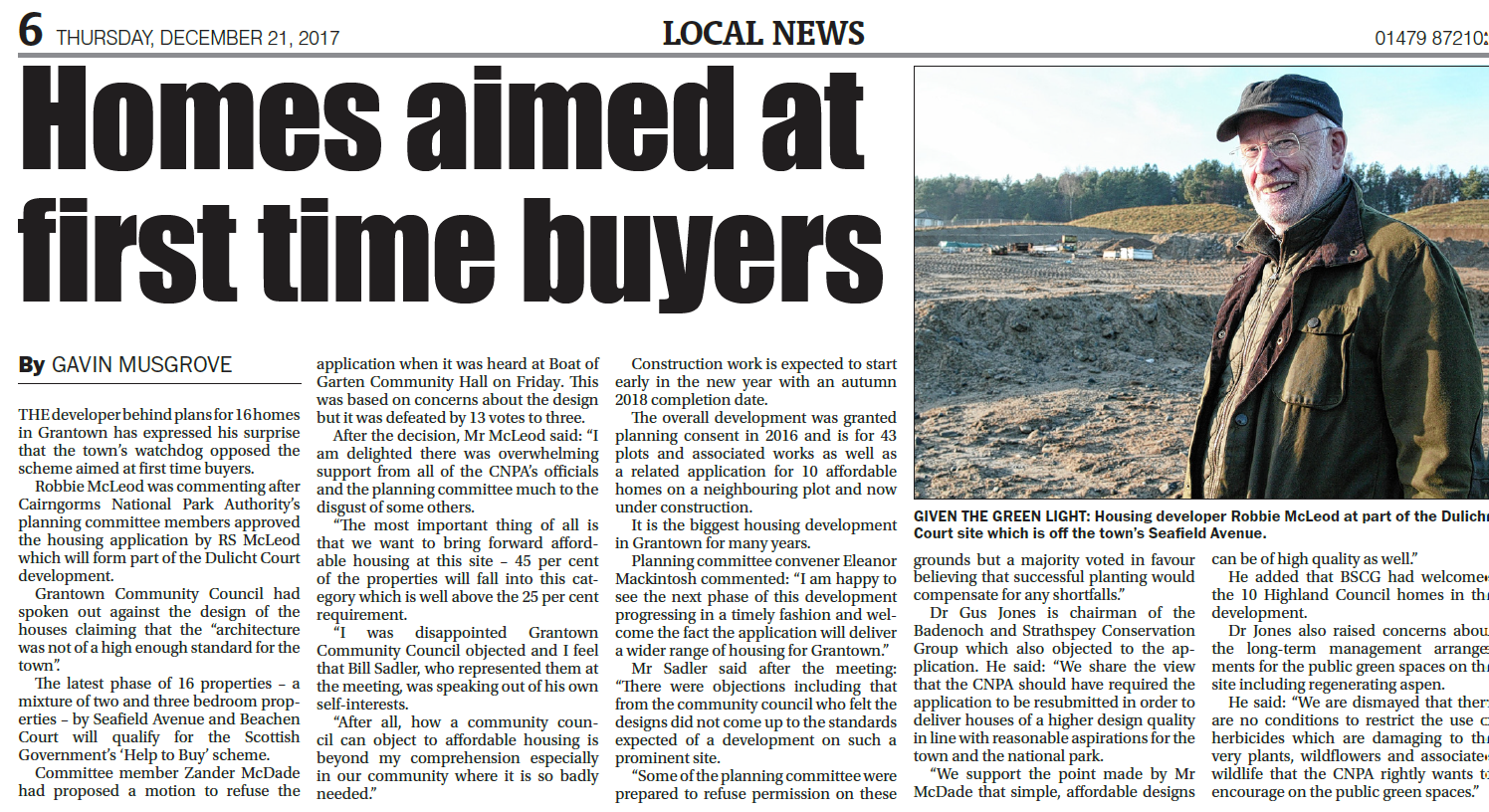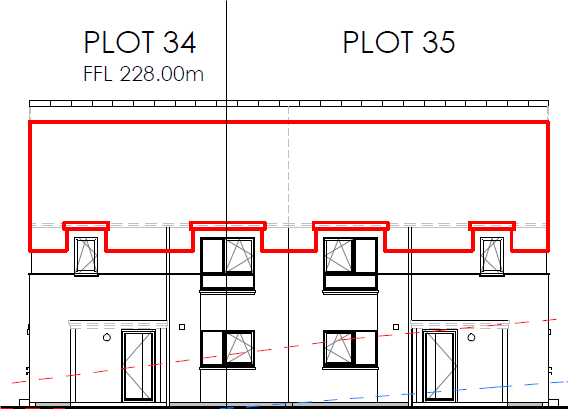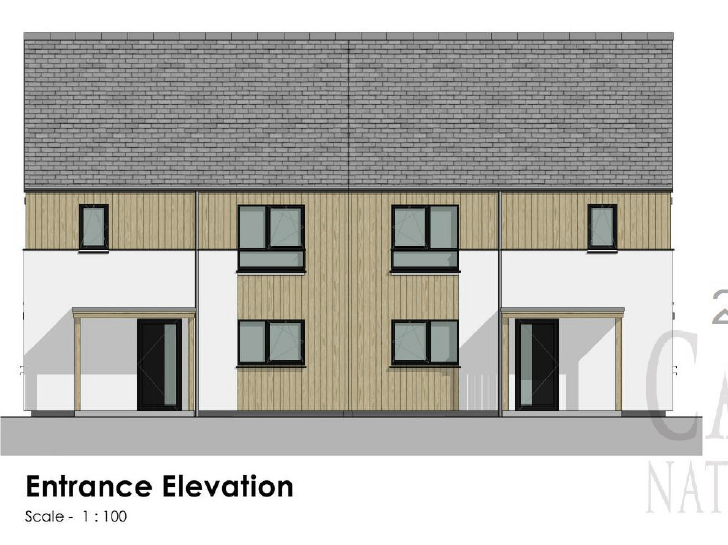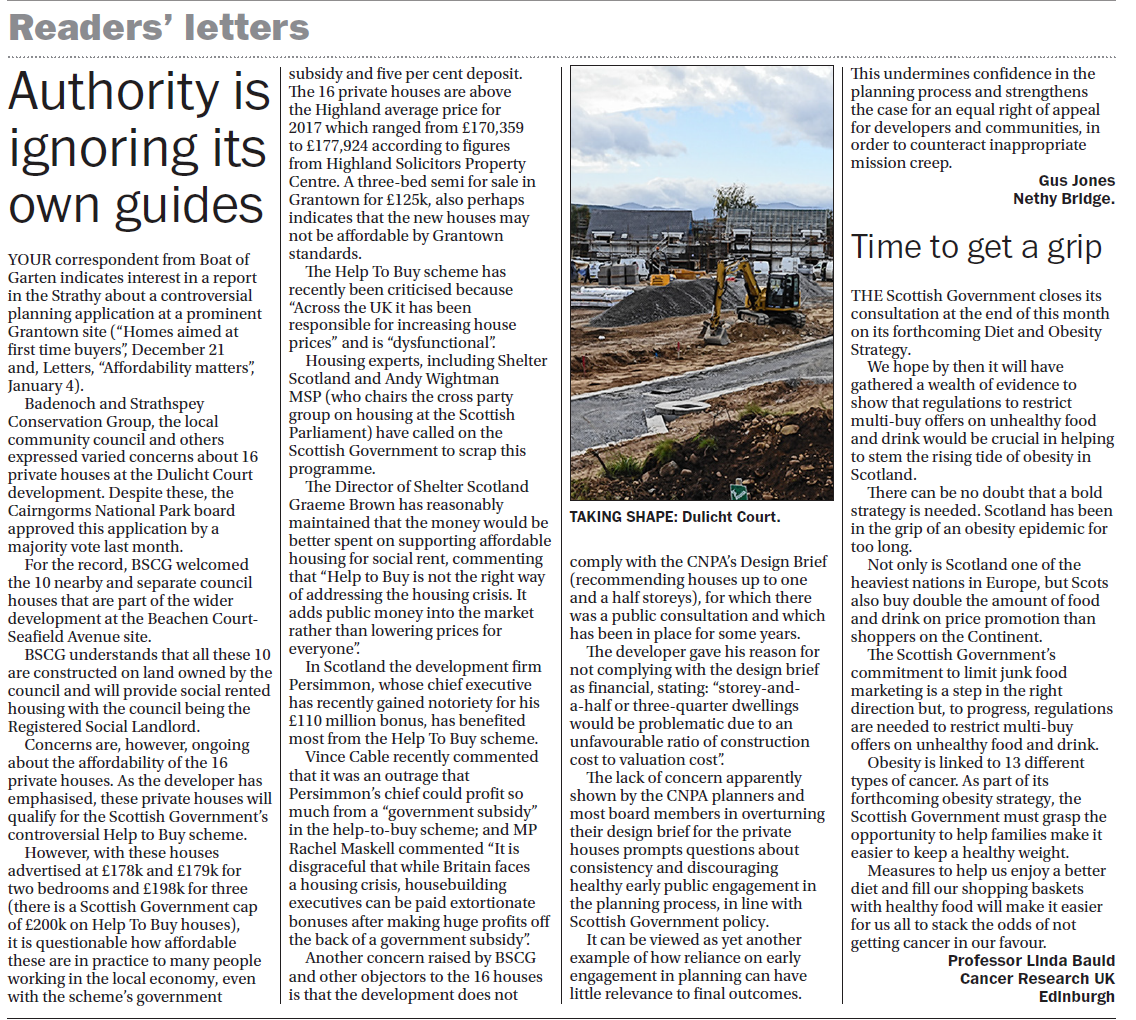
I have been aware of the Beachen Court housing development at Grantown for some time. I believe it illustrates many of the fundamental issues facing the Cairngorms National Park Authority in respect to housing and planning, some of which it is currently consulting on in its Main Issues Report (see here). The area, previously flower rich grassland used for informal recreation by local people, had been earmarked for housing in the CNPA Development Plan and subsequent site standards developed through consultation.
The development is taking place in phases, each subject to separate planning applications, subsequent to basic infrastructure being put in place. There have been issues with the developer adhering to the planning conditions for this infrastructure which were referred to at the December CNPA planning committee in their report on enforcement:
a) Beachan Court, Grantown-on Spey
This is a housing development with permission for roads and plot layout for 53 houses (and full permission for 10 affordable units granted in October 2016) and included a range of conditions dealing with SUDS provision, levels, tree protection and measures for species protection. The opening up of the site, significant infrastructure works and interaction between different conditions has required monitoring to ensure conditions are complied with and development commences in a satisfactory way. The CNPA has investigated a number of enforcement enquiries raised by the public on the site.
Unfortunately the report did not explain what action the CNPA had taken as a result of those concerns. That same meeting, however, also considered a planning application for the second phase of the development (the first phase being the construction of 10 social housing units by Highland Council), the subject of the Strathy article above. The main point of contention in the application (which was objected to by the Community Council) was the proposed design of the housing which breached the design policy the CNPA had adopted for the site: this has originally been that houses should be 1.5 storeys in height (with the upper floor set in the roof) but had been relaxed to a maximum of 1.75 storeys in height. :

The Developer argued that full height two storey houses were needed to make the houses “affordable”:
The Design Statement explains that the type of housing complies with the Scottish Government’s “help to buy” scheme which helps buyers who would not otherwise be able to do so to buy a new home. The applicants assert that this has meant that 1 ¾ storey houses would be difficult to provide given the ratio of construction costs to valuation costs and this has led to the current proposal for two storey houses. The statement seeks to addresses the relationship to the original design brief as approved for the wider plot layout which set out design principles for future development and included a statement that all new housing would be a maximum of 1 ¾ storeys high which was reflected in the planning conditions attached to the original plot layout consent here.

CNPA staff had this to say about the proposed design:
In terms of the design the houses types are considered to be functional and satisfactory, of simple design incorporating an acceptable range of materialswere not exactly enthusiastic about the standard of the design
Hardly an enthusiastic endorsement, but they nevertheless recommended the designs be approved:
61. It is appreciated that the guidance contained in the non-statutory development brief for this site set out that development should be up to 1 ½ storeys. This was amended in the subsequent application for the wider site where 1 ¾ storey development was put forward in the accompanying design and access statement. The applicant is now putting forward the case for 2 storey housing on the application site. The financial reasons behind this are not considered to be an overriding planning consideration, but simply an explanation from the developer as to why they have gone down this route. The land use planning consideration here is simply whether or not on these particular sites two storey properties as proposed are acceptable.
62. Given that the house designs are satisfactory, there are no adverse impacts on amenity of neighbours and sections demonstrate that the houses will sit acceptably on the sites there is no planning policy reason to refuse the application simply because it does not comply fully with the guidance contained in the design brief and development brief.
What message does it give to developers if development briefs can be ignored? If planning in the our National Parks is to become really effective, our National Park Authorities need to hold developers to agreed design briefs and to adherence to planning conditions. I suspect the CNPA is storing up problems for itself for later phases of the development of this site (and its worth saying here there were many excellent elements in the original design brief including such things as dedicated cycle storage facilities – the proportion of National Park residents who cycle is very high) and the developer will come back with further proposals to relax the original design brief in later stages of the development. We will see!
While the Planning Committee approved the proposal, to their credit three members of the Board supported an amendment that the CNPA should stick to their policy. Further the mover of the amendment, the new Board Member nominated by Perth and Kinross Council, Xander McDade (referred to in the article above), hit the issue on the head when he stated it should be possible to provide high quality affordable housing, a challenge to the Developer’s claims that the changes were necessary to make the housing affordable.

Gus Jones, Convener of the Badenoch and Strathspey Conservation Group had an interesting letter in the Strathy last week about the decision which focusses on the alleged merits of the Help to Buy Scheme as a means of providing affordable housing.
The underlying issue here is the price of land. This was subject to a very interesting report from the Scottish Land Commission Land Lines. The housing land market in Scotland.The report is well worth reading in its entirety for anyone who wants to understand the housing market and its findings are very relevant to the CNPA’s consultation on its Main Issues Report.
Main findings
• House prices have risen dramatically in Scotland in recent decades, far outpacing
growth in incomes. The driving force behind rising house prices has been increasing
land prices.
• The way the land market operates depends largely on the laws, institutions and
political history of particular nations, and so varies widely. In Scotland, the key
characteristics are a reliance on the private sector operating on a speculative model
to deliver new house building; a legal framework that allocates the uplift in the
value of land resulting from planning permission to landowners rather than public
authorities; a liberalised mortgage credit market; a taxation system that is highly
favourable to land and property; and a paucity of publicly available information on
land values and ownership.
• This system has resulted in an under-supply of housing and escalating housing
costs, which in turn has undermined living standards, exacerbated economic
inequality, and stifled productivity growth and output.
• Policy options to improve the supply of land for housing include public land value
capture, compulsory sale orders, a new housing land development agency, tax
reform, and greater market transparency.
• Intervening in the land market would have a number of long-term economic benefits
including a more productive and dynamic economy; a fairer and more inclusive
society; improved living standards; and healthier public finances.
While I will come back to this in a more detailed consideration of the CNPA Main Issues Report, the relevance to Beachen Court is that good quality housing which met the original design requirements could have been provided for considerably less than £178k for two bedrooms if it had not been for the price of the land. Hence, the message to the CNPA for their Main Issues Report is that if they truly want to deliver affordable housing in the National Park – given the enormous gap between current prices and the average income of residents – they need to start tackling the land question.

Yet again ‘affordable’ is equated with ‘lacking in imagination’… Something that cannot be said of the landscapes of the Park. Affordable housing doesn’t have to be like this but it does require the developer to show some interest. Clearly they need prodding to do this… What a shame the Park isn’t interested in doing this. Isn’t there anyone in the Park’s expansive planning team with the vision to work with a developer on designs that live up to the landscape? Take a look at what one (Scottish) architect is doing for affordable rural house design then compare and contrast .. http://www.ruralhouse.co.uk
The tradgedy of allowing this style of property could so easily be avoided if developers and council officers would look around the country and see what those with a little imagination and vision can achieve. In the Cairngorms they should aim to be at the forefront of house development, with far greater respect for not only the countryside but more importantly those people that will make these houses their homes